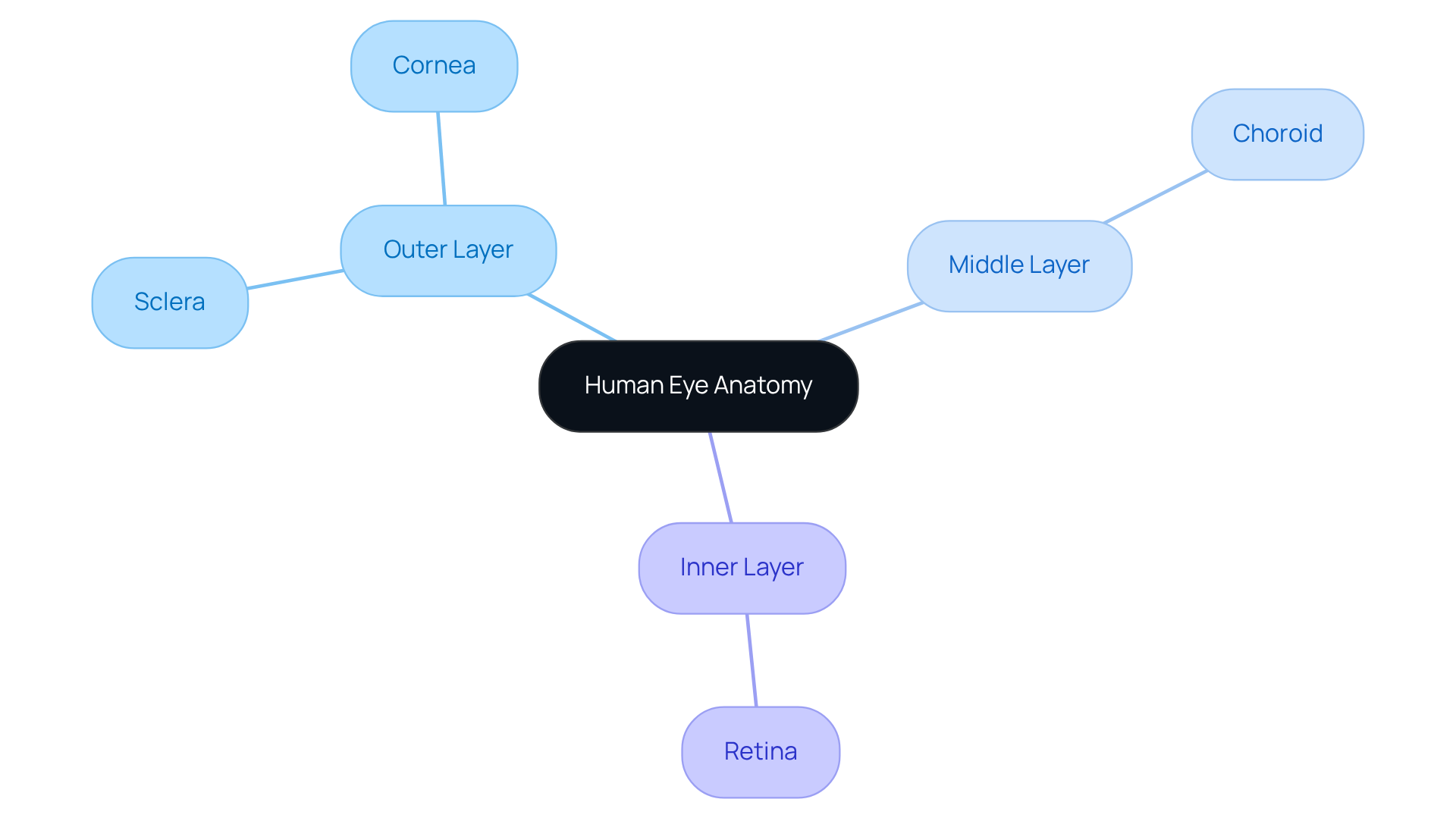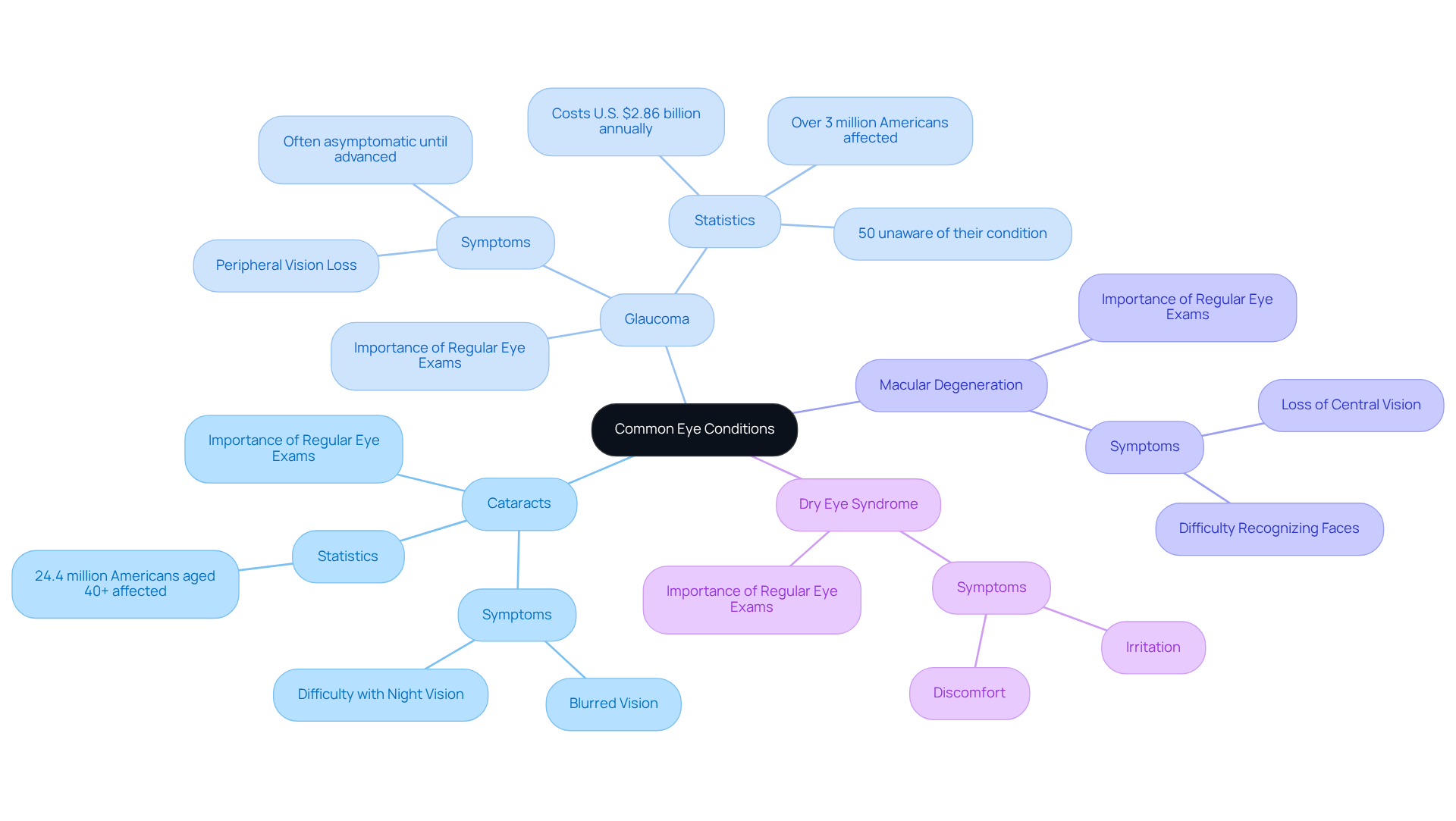Posted by: Northwest Eye in General on July 25, 2025
Overview
This article highlights the essential components of eye anatomy and their connection to common eye conditions, emphasizing how crucial it is to understand these aspects for maintaining your vision health. We recognize that many people have concerns about their eye health, and it’s important to address those feelings. By detailing the functions of the eye’s structures, such as the cornea and retina, we can link them to conditions like cataracts and glaucoma. It’s common to feel uncertain about these issues, but understanding them can empower you.
Regular eye examinations are vital for detecting and addressing potential problems early. We encourage you to prioritize these check-ups, as they play a significant role in safeguarding your vision. Remember, you are not alone in this journey; we are here to help you through the process, ensuring you receive the care and support you need.
Introduction
Understanding the intricate design of the human eye is essential for anyone concerned about their vision. We understand that your eyesight is precious, and the eye, a marvel of biological engineering, comprises several key components that work in harmony to facilitate sight. This article delves into the anatomy of the eye, illuminating the roles of its various structures and how they relate to common eye conditions.
It’s common to feel overwhelmed when considering what happens when these components malfunction. However, knowledge of eye anatomy can empower you to take charge of your eye health.
Explore the Basics of Eye Anatomy
The human eye is a complex organ that plays a vital role in our ability to see. We understand that many may have concerns about their vision, and it’s important to know that the eye is composed of several key structures, each with a specific function. The eye can be divided into three main layers:
- The outer layer (sclera and cornea)
- The middle layer (choroid)
- The inner layer (retina)
Each of these layers contributes to the overall function of the eye, allowing it to capture light and convert it into visual signals that the brain interprets as images.
Grasping these layers is crucial for identifying how different eye issues, such as cataracts and glaucoma, can influence vision. At Northwest Eye, we focus on addressing these issues, offering advanced cataract surgery and other cutting-edge therapies. We understand that knowledge of the not only enhances patient awareness but also empowers individuals to seek timely medical intervention, ultimately improving their eye health.
To support this understanding, Northwest Eye offers educational resources like the Eye Condition Library and symptom checkers, which help patients better comprehend their conditions. As Dr. Ming Wang, a renowned eye surgeon, emphasizes, “The intricacies of the eye cannot be overlooked in the pursuit of effective treatment.” This highlights the importance of understanding eye anatomy, as illustrated in the eye anatomy diagram, in relation to the advanced technology and state-of-the-art facilities available at Northwest Eye, ensuring high-quality care for all patients. We are here to help you through this process.

Identify Key Components of the Eye
The eye consists of several essential components, each playing a significant role in the process of vision:
- Cornea: This clear, dome-shaped surface covers the front of the eye and is responsible for about two-thirds of its optical power. It bends light rays to help concentrate them onto the retina, which is crucial for achieving clarity of sight. We understand that changes in the cornea can significantly affect refractive outcomes, with the being a dominant factor in refractive shifts.
- Pupil: The pupil is the opening in the center of the iris that regulates the amount of light entering the eye. Its size adjusts according to lighting conditions, ensuring optimal light levels for your sight.
- Lens: Positioned behind the pupil, the lens further focuses light onto the retina. It is flexible, allowing it to change shape for focusing on objects at varying distances, a process known as accommodation. The M7 value for accommodative intraocular lenses is +1.35 diopter/mm, highlighting the lens’s important role in correction.
- Retina: The innermost layer of the eye, the retina contains photoreceptor cells (rods and cones) that convert light into electrical signals. These signals are then transmitted to the brain via the optic nerve, enabling you to perceive images.
- Optic Nerve: This vital structure transmits visual information from the retina to the brain, where it is interpreted as images. It’s common to feel concerned about the potential impact of any harm to the optic nerve, as it can lead to significant loss of sight.
Understanding the functions of these components, as shown in an eye anatomy diagram, is crucial for recognizing potential eye health issues. Recent information shows that factors impacting the cornea, such as keratoconus, can lead to significant visual impairment if not addressed promptly. Eye care specialists emphasize that maintaining the health of these components is essential for overall sight quality.
At Northwest Eye, we provide educational resources, including the Eye Condition Library and symptom checkers, to empower you in understanding your eye health. By studying an eye anatomy diagram that illustrates the roles of the cornea, pupil, lens, retina, and optic nerve, you can better understand your eye health and the importance of regular eye examinations. We are here to help you through this process.

Connect Anatomy to Common Eye Conditions
Understanding the connection between eye structure and is essential for recognizing symptoms and seeking timely care. We know that eye health can be a source of concern for many individuals, and addressing these issues early can make a significant difference. For instance:
- Cataracts: This condition involves the clouding of the lens, often associated with aging, leading to blurred vision that can greatly affect daily activities. It’s estimated that approximately 24.4 million Americans aged 40 and older are affected by cataracts. This statistic underscores the importance of regular eye exams for early detection and intervention.
- Glaucoma: Often described as the ‘silent thief of sight,’ glaucoma is characterized by elevated intraocular pressure that can damage the optic nerve, resulting in permanent vision loss. Many people may not realize they have glaucoma until significant damage occurs, with over 3 million individuals in the U.S. affected, and about 50% unaware of their condition. Globally, around 60 million people suffer from glaucoma. Early detection through comprehensive eye exams is crucial, as treatments can slow or even halt the disease’s progression. The financial impact is also significant, with glaucoma costing the U.S. $2.86 billion annually in medical expenses and lost productivity, highlighting its importance beyond individual health.
- Macular Degeneration: This condition affects the retina and can lead to a loss of central vision, impacting essential activities like reading or recognizing faces. We understand how this can be distressing, and knowing the signs can help in seeking timely care.
- Dry Eye Syndrome: Insufficient tear production can lead to discomfort and potential vision problems, affecting the cornea and overall eye health. If you experience irritation, it’s important to address it with your eye care professional.
By understanding how these conditions relate to the eye’s anatomy through an eye anatomy diagram, you can appreciate the vital role of regular eye exams and proactive eye care in maintaining your vision health. Remember, we are here to help you through this process, ensuring that you receive the care you need for optimal eye health.

Conclusion
Understanding the intricate anatomy of the eye is essential for appreciating how this remarkable organ functions and how various conditions can impact vision. We understand that many may have concerns about their eye health, and this article emphasizes the significance of the eye’s three main layers—outer, middle, and inner—as well as the critical components such as the cornea, pupil, lens, retina, and optic nerve. Each part plays a vital role in the complex process of vision, and recognizing their functions can empower you to take charge of your eye health.
Key insights shared include the importance of regular eye examinations for early detection of common eye conditions like cataracts, glaucoma, macular degeneration, and dry eye syndrome. It’s common to feel uncertain about these issues, but by connecting the anatomy of the eye to these prevalent concerns, the article highlights how understanding these relationships can lead to better awareness and proactive care. The resources provided by Northwest Eye, including educational materials and symptom checkers, serve as valuable tools for those seeking to enhance their knowledge and maintain their eye health.
Ultimately, fostering a deeper understanding of eye anatomy not only aids in recognizing potential issues but also underscores the importance of seeking timely medical intervention. By prioritizing eye health and utilizing available resources, you can ensure you receive the care necessary for maintaining optimal vision and overall well-being. We are here to help you through this process, supporting you every step of the way.
Frequently Asked Questions
What are the main layers of the human eye?
The human eye is composed of three main layers: the outer layer (sclera and cornea), the middle layer (choroid), and the inner layer (retina).
What is the function of the eye’s layers?
Each layer of the eye plays a specific role in capturing light and converting it into visual signals that the brain interprets as images.
Why is understanding eye anatomy important?
Understanding eye anatomy is crucial for identifying how different eye issues, such as cataracts and glaucoma, can influence vision and for seeking timely medical intervention.
What services does Northwest Eye provide related to eye health?
Northwest Eye offers advanced cataract surgery and other cutting-edge therapies, along with educational resources like the Eye Condition Library and symptom checkers to help patients understand their conditions.
Who emphasizes the importance of understanding eye anatomy in treatment?
Dr. Ming Wang, a renowned eye surgeon, emphasizes that the intricacies of the eye cannot be overlooked in the pursuit of effective treatment.
How does Northwest Eye ensure high-quality care for patients?
Northwest Eye utilizes advanced technology and state-of-the-art facilities to provide high-quality care for all patients.






